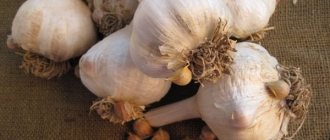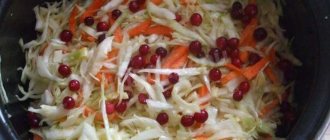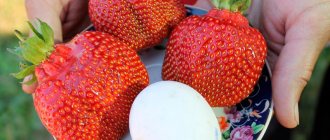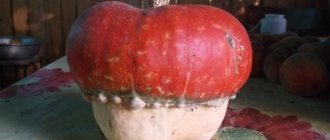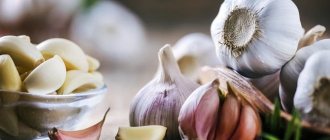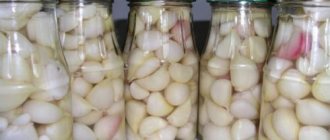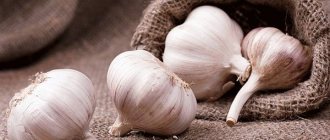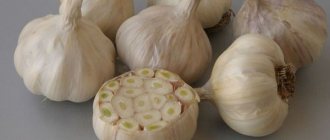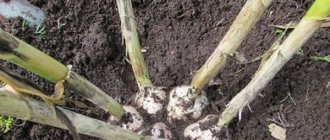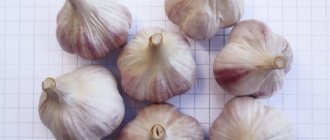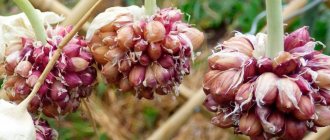Rocambole garlic is a vegetable crop that, unlike conventional varieties, has a pleasant taste and smell. But the main difference between onion and garlic, as gardeners often call it, is its unprecedentedly large size.
Babies grow on the garlic head, which can also be used for planting
Garlic "Rocambole"
"Elephant Garlic" Rocambole
Garlic tops "Rocambole"
This variety has a lot of names - “elephant garlic”, Egyptian onion, Spanish garlic, hair onion, giant garlic onion.
Description of the variety Rocambole
Rocambole is a perennial plant belonging to the lily family. Its above-ground part is very similar to a regular leek, since Rocambole is a hybrid of this onion and garlic. That is why it is often called onion or onion garlic.
The main features of Rocambole garlic:
- Heads of both the first and second years are suitable for food. Although the first-year ones are small, they are in no way inferior in taste to the large second-year ones.
- One bulb of the first year is larger than the largest garlic bulbs.
- The average yield is 3 kg per 1 sq. m.
In the first year of life, the crop forms large bulbs consisting of one tooth. Their weight is 45-50 g. If the climate is warm enough, then in the second year of life the crop produces a bulb much larger than the previous one, weighing up to 80 g per clove. This is a heat-loving crop; under favorable circumstances, the bulb grows up to 500 g.
Description of culture:
- Trunk. Thick, high density. Height 80-120 cm - depends on soil fertility.
- Leaves. Dense and wide, pale green in color, with a silvery, waxy coating. On the stem there are 6-9 leaves 30-60 cm long and 3-6 cm wide. The leaf blades are flat, with longitudinal stripes, pointed towards the apex. The leaves have a slight bend in the center.
- Inflorescences. Large, attractive - the plant is often used as a decorative one. The inflorescence is spherical, collected from small purple flowers. There are no seeds in inflorescences.
- Bulb. In the third year it usually has from 4 to 6 cloves. The diameter of the head is 6-10 cm. The length of one segment can reach 15 cm.
Onion garlic blooms in July. The plant develops a flower-bearing arrow 1 m long. In two-year-old garlic, stolons with baby bulbs of 1.5-4 g each form on the bottom. They have a yellow-brown husk, in contrast to the large white onion. If the stolons are short, then the children are tightly pressed to the cloves and covered with the white husk of the mother’s bulb.
Description of the plant
Hair onion (rocambole) (Allium scorodoprasum L.) is a perennial herbaceous plant of the onion family. For economic purposes it is grown as a one- or two-year crop. It belongs to the mid-season variety: it reaches technical maturity 110-120 days after emergence. Its aerial part is very powerful and tall. The leaves are narrow-linear with a central vein, green, with a waxy coating, long, ciliated along the edge. They are erect or slightly spreading.
The inflorescence is spherical, lilac in color
The bulb is round or flat-round, with a diameter of 6-10 cm, weighing 40-80 grams. It can be single-pronged or divided into 4-6 teeth. Usually the lobules are the same in shape and size, but smaller or double ones are also found. The color of the integumentary paper-like scales of the bulb and cloves is white or yellowish; juicy pulp – pale yellow.
Beneficial features
In 2015-2016, specialists from the All-Russian Scientific Research Institute of Selection and Seed Production of Vegetable Crops assessed the nutritional significance of the species as a source of microelements useful for the human body in the field conditions of the Moscow region. Analysis of the results obtained shows a high potassium content, similar to winter garlic. Rocambola contains more phosphorus than calcium, the amount of magnesium is higher than the level of sodium and iron, silicon and iodine are present. It has been established that this vegetable is not an active accumulator of toxic substances (arsenic, mercury, lead, etc.). Its biochemical composition contains many vitamins (C, E, K, PP and group B), amino acids and other bioactive substances.
Young leaves and bulbs are used for food in fresh, pickled, salted and dried form.
Onion-garlic has a pleasant pungent taste and a delicate garlicky smell. Essential oils and phytoncides give it a special aroma. In cooking, greens and onions are used raw, adding to salads, cheese and cottage cheese snacks. The heads are salted and pickled, making savory preparations that are good served with soups, meat and fish, baked vegetables, stews, pilaf and other dishes.
What types and varieties are there?
There are two types of garlic onions:
- in the selection of which the hair bow was used.
- in the selection of which grape onions were used.
In the Russian Federation, only two varieties of onion garlic are officially recognized:
- Pearl. Frost-resistant variety bred by Moscow breeders. The crop is mid-season, suitable for cultivation in all regions of the Russian Federation. It is cultivated similarly to winter garlic. It has long arrows - up to 60 cm, wide leaves - 3 cm. The heads are flattened, with white scales. Weight – 50-55 g. Number of cloves – 4-6 pieces. The pulp is yellowish, with a pungent taste. From 1 sq. m harvest up to 2 kg of garlic onions.
- Janissary. New winter-hardy variety. Suitable for all regions of Russia. Leaves are 40 cm long, 3.5 cm wide. Weight – 95 g. Number of cloves – 6 pieces. The scales of the bulb are creamy, and the flesh is yellowish.
Our gardeners grow another variety of Belarusian origin - white elephant . It was bred specifically for regions with harsh winters. It does not have flower arrows. Bulb weight – 150-200 g. Number of cloves – 6-7. The flesh when cut is yellowish. The variety is resistant to fusarium. Productivity – 3 kg per 1 sq. m.
About culture
Garlic is a perennial plant, a vegetable crop, popular among many peoples of the world due to its pungent taste and characteristic aroma. Onion is a herbaceous plant from the amaryllis family. Few people know about the hybrid of these two crops called Rocambole. But once you plant it on your personal plot, it becomes the favorite of all summer residents.
Onion-garlic Rocambole has unique features:
- Size. The cloves grow up to 15 cm if there are no more than 3 of them in the head. The size of one large fruit exceeds the size of a tennis ball.
- Fetal weight. Reaches 400 grams.
- Appearance . In the first year, Rocambole looks like a leek, in the second it looks like a large onion. One-toothed garlic planted in the spring will produce large garlic in 3.5 months.
- Thick stem, and a large number of leaves on it. The tops reach a height of 30-60 cm.
- High yield. Up to 3 kg of crop is harvested from 1 m² of bed.
- Taste qualities. Rocambole combines the aroma of onion and garlic at the same time.
The giant garden plant is popular in Russia, especially in Crimea and Siberia. In the middle zone it is much less common, although it easily grows in the climatic conditions of the European part of our country.
Value and benefit
Greens and giant garlic bulbs have a rich mineral and vitamin composition. The taste of Rocambole harmoniously combines notes of onion and garlic. Onion garlic does not give off a characteristic garlic smell after consumption. It contains a lot of vitamins A, C, E. The vegetable is rich in carotene and iron. It contains antiseptics and essential oils. Energy value – 150 kcal per 100 g.
Benefits of Rockambol:
- acts as a natural antibiotic;
- tones blood vessels, dilates them, makes them more elastic, improves blood flow;
- prevents the formation of blood clots;
- reduces the content of bad cholesterol;
- improves the functioning of the digestive system;
- strengthens the immune system;
- restores a weakened body;
- cleanses the body of toxins;
- improves appetite, activates the production of gastric juice;
- strengthens gums;
- strengthens hair and promotes its growth - when used externally;
- relieves nasal congestion - thanks to the secreted essential oils.
Rocambol, while helping with various diseases, cannot be the main medicine. Due to its pungency, this vegetable is consumed in moderation. Possible side effects:
- headache;
- blurred vision;
- diarrhea;
- skin irritations;
- vascular spasms.
Contraindicated:
- children under 3 years old;
- pregnant women;
- people with diseases of the kidneys, stomach, gall bladder;
- with internal bleeding.
Preparation of planting material
The day before planting, they begin to prepare planting material.
- Multi-clove bulbs are divided into individual cloves, removing excess husk. If there is an old bottom left on them, it is also removed. Children are also used for planting; they have a denser, bright yellow skin, which must first be removed.
Single cloves, cloves and children are used as planting material for rocambole garlic.
- Planting material should be sorted by size (i.e. sized) to ensure more uniform heads in the future. This is a very important element of preparation: you need to try to plant cloves of equal size next to each other, so that later the stronger plants do not overwhelm the weaker ones.
- Disinfect overnight in a 0.05% solution of potassium permanganate (dissolve 0.5 g of potassium permanganate in 1 liter of water).
Preparing for landing
Rocambole is grown like simple garlic. The soil and planting material are prepared for planting. It is better to buy domestic planting material for planting - it tolerates frost better. Foreign varieties are suitable only for regions with warm climates.
The soil
In the middle zone and in more northern regions, Rocambole is planted in areas illuminated by the sun throughout the day. Due to shading, the number of cloves in the head decreases and diseases appear.
Features of preparing a site for planting Rocambole:
- The best option is neutral soils. If the soils are acidic, they are alkalized during autumn digging.
- When digging, humus or compost is added to the soil - 5-6 kg per 1 square meter. m, wood ash (500 g) and bone meal (150-200 g).
- The soil in the beds is loosened to a depth of 20-25 cm. Giant garlic produces good yields in high beds.
- Culture is demanding of predecessors. Prefers legumes and melons, cabbage, cucumbers. Undesirable predecessors are garlic, onions and potatoes, since the pests remaining in the soil after them will actively attack Rocambole.
Planting material
Children, cloves or annual bulbs are prepared for planting. Usually up to 15 children grow on one bulb. Planting material is placed in the refrigerator for a month. After hardening, the material is disinfected - the teeth are placed in a solution of potassium permanganate for 20 minutes. Instead of potassium permanganate, you can use boiled ash - for 1 liter of boiling water you need a glass of ash. Boiling time – 10 minutes. When the broth has cooled, the cloves are placed in it.
Landing
Planting Rocambole on a site is a multi-step process. The summer resident needs to prepare the beds, fertilize the soil, and choose the right planting material.
Soil preparation
The soil for planting Rocambole must be prepared in advance, at least a month before the agrotechnical measures for planting the cloves in the ground. For spring procedures, it is better to form the bed and fertilize it in the fall.
To prepare the soil for planting Rocambole, carry out the following activities:
- Clear the area under the beds of debris and grass. Dig the soil to a depth of 25 to 30 cm.
- Add sand and peat to the soil in equal parts. Garlic onion loves loose, airy soil.
- If the acidity level in the soil in the garden is high, reduce it with wood ash or dolomite flour, 2 cups per 1 m² of soil.
- Fertilize the soil with humus or rotted manure, adding 30 kg of the substance per m² to the bed.
- Add mineral fertilizers: potassium and phosphorus at 30-40 g/m².
- A day before planting, loosen the soil again and water the soil.
Rocambole loves moisture and warmth, so choose a sunny place with high groundwater levels for the garden bed. Water the garlic frequently with warm water after the first sprouts emerge.
Preparation of planting material
The yield of the vegetable depends on the quality of planting material.
The teeth must meet the following characteristics:
- large size;
- no damage;
- healthy appearance;
- same size.
It is not advisable to plant small and large samples side by side in one bed, otherwise the stronger seeds will crowd out and destroy the weaker ones.
When the material is selected, the teeth should be cleaned of the upper scales and soaked in warm water for a day. To stimulate growth and disinfect seeds, you can add potassium permanganate to the liquid, making a weak, barely pink solution.
It is better to plant Rocambole in the places where beets, cabbage, greens or green manure grew last year. Potato plots will not be suitable for giant garlic onions for another 4 years.
Landing
Rocambole can be planted in the ground in spring, autumn and before winter. The choice of season depends on the variety of onion and garlic and the climatic conditions of the region.
Autumn
Rocambole is usually planted in the fall in regions with a moderately cold climate, 3-4 weeks before the onset of frost. The period from the second half of September to the end of October is suitable.
Winter onion-garlic is planted as follows:
- First make the beds in the form of furrows. Fertilize the soil before planting.
- Deepen the planting material into the soil so that the tops of the cloves are hidden 8-9 cm underground.
- There should be 10-12 cm between the cloves, and at least 30 cm between the furrows.
- Water the onions immediately after planting.
- Mulch the top with sawdust, hay, and peat. You can cover the bed with a lattice if the weather is windy and you are afraid that the mulch will fly away.
On a note! When the onion is ready to split into cloves, the shoot will shoot out an arrow. It is advisable to remove it in the early stages of development so that the vegetable gains more mass.
For the winter
In the northern regions, planting garlic onions for the winter is impossible. The vegetable freezes. It is necessary to plant Rocambole in open ground for the winter in areas with a warm climate in the same way as during autumn events. But do not forget to carefully cover the bed.
in spring
The spring months are suitable for planting spring Rocambole in the Urals, in the Middle Zone, and in the Far East. Carry out agrotechnical measures immediately after the snow melts; garlic onions need low soil temperatures to take root. The ideal period is from April 15 to May 5.
- Prepare the beds in the fall or fertilize the soil immediately before planting the cloves. Pour ash and complex fertilizers into the furrows at a dosage of 30 g per 1 m².
- Loosen the soil to a depth of 30 cm.
- Water the garden bed thoroughly if it has dried out after the winter.
- Place the cloves in the soil so that the soil covers them 5-8 cm from above.
- Plant large segments less often, small ones more often from each other.
On a note! Onion-garlic Rocambole is an unpretentious crop, but demanding on soil quality. Without fertilizers and fertilizing, it will not be possible to grow giant fruits.
Landing requirements
Rocambole is planted at any time - in spring or autumn. If the region has very harsh winters, then it is better to choose spring planting, since garlic planted in the fall runs the risk of freezing. If you plant garlic in the fall, you need to insulate the planting.
Landing requirements:
- Pre-winter. Planting is done three weeks before the onset of frost. During this time, the garlic will take root, but will not have time to germinate. For the middle zone, the suitable planting time is in the first half of October.
- Spring. Planting material is planted as early as possible - enough for the soil to warm up to +6 °C. Short-term frosts are not scary for onion garlic; it will take root well at +3...+5 °C. The recommended planting time for the middle zone is from mid-April to early May.
Varieties of onion-garlic rocambole
Rocambole has been developed into two forms: from the hair onion and the grape onion. In addition, all crop varieties are divided into spring, winter and universal.
- Spring varieties of rocambole are planted in early spring after the soil has warmed to + 4–6°C, which is typical for mid-April.
- Winter varieties of garlic and onions are planted before winter and do this long before the onset of frost. In different regions, this period is extended in time and takes place from the end of September to mid-October.
- Universal varieties are suitable for planting in both spring and autumn.
So far, only three varieties of rocambole are grown in Russia:
- White elephant. This variety of onion-garlic of the Belarusian selection is characterized by resistance to bottom rot, excellent cold resistance, and the absence of arrows. In an onion weighing up to 200 g, 6–8 milky teeth are formed.
- Pearl. This variety has smaller heads (up to 50 g) than the White Elephant, while the taste of the cloves (there are from 3 to 6) is sharper. Despite the tendency to bolt, Zhemchug is a high-yielding and cold-resistant variety.
- Janissary. A new (registered in 2016) and already quite popular variety of rockambole. The bulbs are large, up to 500 g, and have a medium-spicy taste. Weakly affected by viruses and fungi. Does not tolerate cold weather.
Step-by-step instructions for planting
Step-by-step instructions for autumn (pre-winter) planting:
- The planting pattern depending on the choice of planting material is in Table 1.
- After planting, the bed is sprinkled with mulch - for example, straw or sawdust. Mulching protects the onion garlic from low temperatures and retains moisture.
- Winter Rocambole is ready for harvesting in the first half of August.
- When preparing the beds, the furrows are made deeper than during spring planting.
- Unlike spring planting, planting material can do without disinfection;
- 6-8 cm of humus is placed at the bottom of the beds.
In this video you can see how to properly plant Rocambole garlic:
Table 1
| Planting material | Planting depth, cm | Distance between adjacent rows | Spacing between adjacent plants | What will grow next year? |
| Children or teeth | 8-10 | 25 | 15-20 | single clove bulbs |
| Single clove bulbs | 4 | 20 | 25 | ripe fruit of several cloves |
Step-by-step instructions for spring (spring) planting:
- A month before planting, the seeds are hardened and disinfected. Planting is carried out according to the 20 x 25 pattern - between planting material and rows, respectively.
- If the weather is dry, the beds are watered.
- Spring Rocambole is harvested in the second half of September.
Rocambole: agricultural technology with precision down to the smallest detail
Some farmers recommend treating it like garlic. One technology is used for winter varieties, and another for hard varieties. It is this feature that determines the time when to plant rocambola. Gardening work is carried out either in early spring (March, April) or late autumn. By the given period, the air temperature will approach the optimum - 8-15˚C, and the ground will become quite moist.
Choose a well-lit place for agriculture. Then the soil will warm up perfectly during the day. In addition, when planting and caring for rocambole, you need to follow the crop rotation technique.
The predecessors of this variety of garlic should not be bulbous crops. In front of him in the garden should grow:
- tomatoes;
- cucumbers;
- zucchini;
- pumpkin;
- legumes;
- cabbage.
There is no need to waste time planting rockambole. If you plant it in dry soil, only the leaves will grow, not the roots.
The soil for planting must be prepared in the fall. To do this, add up to 40 g of potassium salt and superphosphate per 1 m². If possible, wood ash is added to these fertilizers in a proportion of 110-190 g/m². If it was not possible to carry out such activities in October, then in early spring the site is fertilized with complex compounds or ash (30-40 g/m²). Farmers are also advised to use rotted manure, which contributes to good yield of onions.
Growing rocambola in spring requires stratification of planting material. Before planting, the bulbs must be stored in the refrigerator for a month.
Preparatory work and the process of planting rockambole
First you need to sort large, small and medium onions. Then they should be carefully divided into cloves, which should also be calibrated. This procedure is the most important in rocambola agricultural technology, since the productivity and yield of the crop depends on it.
Further actions of the farmer come down to:
- removing excess husks;
- removing bright yellow skin from babies;
- soaking the bulbs in a solution of potassium permanganate or ash lye for 8-10 hours.
To prepare ash lye, you will need to dissolve ash in a glass of 200-250 ml of water. The mixture must be boiled for an hour. After cooling, it should be strained.
The listed procedures are mandatory when growing rockambole from children. In addition, the gardener is required to thoroughly loosen and moisten the bed.
Also, the farmer should strictly adhere to the crop planting scheme:
- embedment depth - 8-10 cm;
- interval - 15-18 cm;
- the distance between rows is 30 cm.
To protect the plant from the cold and retain moisture in the ground, the area is mulched. A mixture of peat, straw, and sawdust is used as such shelter. The thickness of such a layer should be more than 5 cm.
Methods of propagation of rocambole largely depend on the crop variety. In some cases, this is done with the help of seeds or children, in others - with cloves or obdonos.
How to care?
Rocambole is not only similar to garlic in appearance, but also in agricultural technology. There is nothing special about growing onion garlic. Caring for the crop comes down to watering, fertilizing and loosening.
Top dressing
The culture is responsive to fertilizing. The task of vegetable growers is to grow large and tasty bulbs, and this requires fertilizers. Recommended fertilizing:
- Immediately after germination, nitrogen fertilizers are applied. For example, ammonium nitrate - 10-20 g per 1 sq. m.
- When 4 leaves are formed. Bird droppings (1 cup) and urea (1 tbsp) are dissolved in a bucket of water (10 l). For 1 sq. m add 3 liters of this mixture.
- 2-3 weeks after the second feeding, the planting is fertilized with a nitrophoska solution. 2 tbsp. l. diluted in a bucket of water - this amount is added per 1 sq. m.
- During planting - phosphorus-potassium fertilizers. A solution of wood ash is suitable for this purpose - 1 glass diluted in 10 liters. For 1 sq. m area, add 5 liters of solution.
Watering
Rockambole loves moisture. Young animals especially need watering. Thanks to abundant moisture, the culture forms a voluminous bulb. The beds with onion garlic are watered 1-2 times a week. The frequency of watering depends on weather conditions. If it is cloudy, one watering per week is enough. The best way to irrigate this crop is drip irrigation.
Weeding
Weeding and loosening are mandatory activities when growing Rocambole. The soil is loosened as soon as the seedlings emerge. Do this carefully, trying not to damage the fragile sprouts and their roots. Thanks to loosening, the soil is enriched with oxygen necessary for the roots, and at the same time weeds are eliminated. They loosen the soil after rainfall or watering, not only between rows, but also directly near the necks of plants.
Flower shoots are removed - this helps to increase the mass of the bulb. There are still no seeds in the inflorescence.
How to grow
Onions and garlic need to be watered regularly. During the period of active growth, it needs to be watered once every three to four days, and at least 12 liters of water should be used per square meter of planting. After the head has already formed, you will need to water the onion-garlic as the soil dries out.
Rocambole needs to be regularly weeded and loosened. As weeds draw nutrients from the soil, this can spoil the crop and reduce its quality. Loosening is also necessary to increase the oxygen that flows to the roots of the plant. In addition, rocamboli needs feeding. As a rule, this procedure must be repeated three times a season. The rules are as follows:
- before sprouts appear, you need to apply nitrogen fertilizers (ammonium nitrate, urea, etc.);
- during active growth, you need to water one square meter of plantings with three liters of solution, which is made from 200 grams of bird droppings, 20 grams of urea and 10 liters of water;
- when the heads form, you need to add fertilizer with a mixture of phosphorus and potassium.
Diseases, pests and prevention
Garlic onions are affected by common diseases and pests of onions and garlic:
- Fusarium. It especially often affects areas where the predecessor is potato. If fusarium appears, the diseased plants are removed and Rocambole is not planted in this place for 3-4 years.
- White rot. To prevent rot, acidic soils are limed, reducing the dose of nitrogen fertilizers.
- Rust. Prevention is similar to fusarium.
- Onion moth, onion fly, nematodes, root mites, thrips.
Methods for controlling diseases and pests are in Table 2.
table 2
| Pest control measures | Disease Control Measures |
| Treatment:
|
General preventive measures for plant protection:
- Selection of healthy planting material.
- Cleaning and burning of plant residues.
- Replanting in one area only after 4 years.
- Disinfection of planting material in a fungicide with a 2-3% concentration.
- Thorough drying of the children after harvesting - the sun's rays kill fungal spores.
- Before planting, the soil is treated with Bordeaux mixture 1% or Fitosporin 15%.
Fungicide treatment is stopped 3 weeks before harvest.
How does it reproduce
Rocambole garlic does not grow in the wild; it is a type of vegetable that was bred in laboratory conditions in nurseries. It needs to be grown and propagated in the garden. The agricultural technology of this unusual vegetable is not standard for other garden crops; to get a harvest, you need to spend 3-4 years.
Growing heads, divided into segments, occurs in stages:
- First year. In the fall, cloves or bulbs of adult rocambole are planted in the garden bed.
- Second year. A one-toothed one grows from a bulb. This is a large onion, undivided into cloves.
- Third year. The one-tooth becomes large and splits into parts.
It is a mistake to believe that Rocambole can be propagated by seeds. Its flowers do not produce them. It is possible to propagate garlic onions only by children that grow on the tips of the bulb and by cloves.
Harvest and storage
Harvesting of giant garlic begins when the lower leaves dry out and the upper ones turn yellow and droop - this happens in the month of September. Storage Features:
- Garlic pulled out of the ground is tied in bunches and dried, hanging upside down.
- Shake off the dried soil, cut off the leaves - leaving a small tail, and store them.
- Store onion garlic in a dry place at a temperature of 9 °C.
Rocambole has good keeping quality - if you provide it with the proper conditions, it retains commercial quality until February, and then begins to germinate.
In Rocambole, not only annual bulbs and biennial heads are eaten - they are eaten fresh, dried, salted and pickled, but also young leaves. Onion garlic is widely used in cooking.
Product storage features
Rocambole should be stored in the same way as regular garlic and onions. First, the bulbs need to be examined for damage and rotten areas. If there are such, then do not collect them in a common bundle. Good bulbs need to be dried, collected in bunches and hung in a sufficiently ventilated area. After drying, it is necessary to trim the roots of the heads and tops, leaving only 1-2 cm.
Rocambole bulbs must be removed from the garden in a timely manner. This must be done before the heads begin to crack and the lobules separate from each other.
Spanish onions are best stored at temperatures between -5°C and +3°C. If the temperature is above +3°C, then the shelf life of the heads will be only 2-3 months. The product can be stored in wooden boxes, nets or fabric bags.
The result of taking rocambola - benefits and harms - depends on the quantity in which this product is consumed. As they say, 1 g of prevention is better than 1 kg of treatment! If you take onion garlic correctly and in moderation (in the absence of contraindications), then it can prevent that same 1 kg of treatment and become a real assistant in the fight against certain diseases!
Reviews from gardeners
★★★★★
Korovin E.P., Luga. I loved rocambole for its taste - it is milder than garlic.
The heads do not deteriorate until the next harvest. I plant it in the fall and grow it like winter garlic. I plant with both teeth and children. You have to mulch the beds - this crop is not as frost-resistant as simple garlic. In our family, besides me, Rocambole has no more fans. Everyone prefers regular garlic; they say that onion garlic has an unpleasant taste. But I sell it well at the market - there is always a demand for huge heads of garlic - they are sold out instantly. ★★★★★
Irina Semyonovna P., Yuryev-Polsky. I planted this Rocambole like a flower, I didn’t even know it was edible.
I bought single-pronged bulbs for planting. Having received the first harvest, I began to propagate garlic by children and single cloves. Not all of the little babies sprouted, maybe because they didn’t clear the husks. But the bulbs produced a decent harvest - bulbs weighing 300 g each. Hide
Add your review
Rocambole is almost exotic for domestic gardens. The culture deserves attention - it has a pleasant taste and many advantages over ordinary garlic. Growing it is not difficult, which means there is every chance to try giant onion garlic from your own garden.
0
0
Copy link
Description of rockambole, history of its cultivation
Rocambole (scientific name: scallion) combines the characteristics of leeks and garlic. This is a perennial herbaceous plant of the Allium genus. It has long (up to 80–120 cm) leaves, reaching 6 cm in width; they are very similar to leek leaves - light green with a waxy coating. A mature rocambole bulb, like a garlic bulb, can be divided into individual cloves. But its taste and aroma characteristics are somewhat different from those of garlic: the pungency in the taste is less, there is no strong smell.
The popularity of rockambole in modern Russia is just beginning to grow. But the first mentions of culture on the territory of our country date back to the end of the 19th century. The country of origin of the plant is Asia, where it is found in its original form to this day. Onion garlic is grown on almost all continents. It is especially loved in the Mediterranean, America and the Middle East. There it is bred on an industrial scale.
Richard Ivanovich Schroeder, considered the patriarch of Russian gardening, at the end of the 19th century in his book “Russian Vegetable Garden, Nursery and Orchard” gave the following characteristics to the plant:
“Rocambole is similar to garlic (which it replaces), but has a less pungent taste. Its stem does not produce seeds. Cultivation and preservation are the same as for garlic. The plant is perennial, grown in Central and Western Europe, Germany and France, but not in large quantities.”
Rocambole combines the properties of leeks and ordinary garlic
People call this unique plant in their own way:
- Egyptian, German, Lebanese, Spanish garlic;
- onion garlic;
- elephant (in the USA) and horse garlic;
- snake bow.
It so happened that the plant, called elephant garlic in the West, in our country is called rocambole, or scallion.
The bulb and leaves of rocambole contain an abundance of vitamins (mostly C and A). And also in its structure there are:
- proteins;
- iron;
- antioxidant allicin;
- carbohydrates;
- carotene;
- essential oil;
- fungicides.
In horse garlic, not only the bulbs are used for eating, but also the ground shoots and foliage. The leaves contain excess ascorbic acid.
Not only the heads, but also the leaves are used for food.
Diseases in which culture has a positive effect on the body:
- viral and fungal etiology, where its action is considered as antibiotic;
- heart and blood vessels: it expands the latter, thereby ensuring normalization of blood flow;
- digestive system (for colitis, diarrhea, tumor processes);
- skin - with suppuration and inflammation;
- oral mucosa (gums);
- hair - strengthens and improves hair growth.
Rocambole is especially useful for people with disorders of the gastrointestinal tract, since its substances have a beneficial effect on the mucous membrane, normalizing its condition.
The plant is capable of forming a powerful flower shoot reaching 1 m - 1.5 m in height. If it is not removed, it will produce lavender-colored flowers in July. They look like miniature bells collected in a spherical inflorescence. Flowers do not produce seeds.
Rocambole arrows form beautiful purple spherical inflorescences
In order to preserve the maximum nutrients necessary for the development of the plant and the formation of the bulb, it is recommended to remove the peduncle. When breeding rocambole for decorative purposes, the arrow-shaped flower stalks and blossoming purple balls are preserved to decorate compositions in flower beds.
Rocambole is a perennial plant from the bulbous family. In the first year of growth, it forms fairly large single-toothed onions, weighing up to 50 g; in the second year of growth, with the required level of heat, it forms a single single-toothed onion, weighing up to 100 g. And only after another year a huge “garlic” will grow from this bulb. If agricultural technology is followed, the size of the head can be about 10 cm in diameter with a weight of up to 300–450 g. When the weather in the season is not warm enough, the growing season of the plant is shortened (rocambole is responsive to heat), then the bulb with cloves will not form, but will grow only in the fourth year.
Children from the bulb are formed from the very root under the integumentary scales and are distinguished by a brown tint. Their number is usually 10–15 pieces, one child weighs 2–4 g. Elephant garlic is a high-yielding crop. From 1 m2 of beds, up to 4 kg of crop harvest is collected. This figure is 5–6 times higher than that of standard garlic.
Harvesting
In order not to lose the harvest, it is worth starting harvesting in a timely manner - if you miss the moment, the cloves and “babies” will disintegrate (removing them all from the ground will be problematic). The risk that the bulbs will begin to rot increases. The signal for harvesting is the drying of the lower leaves and yellowing of the upper ones. For spring planting, harvesting begins towards the end of September, for autumn planting - in July.
For digging, use a flat-toothed fork. The extracted plants are shaken off the ground, the tops are not cut off. The harvest is collected in bunches and hung to dry in a well-ventilated, dry area. After 20 days, the tops are cut off before reaching the head.
Composition and calorie content
The beneficial properties of a hybrid with a pleasant aroma depend on the chemical composition of the vegetable. The fruits and foliage contain:
- vitamins: group B (riboflavin, choline, pantothenic acid, thiamine), ascorbic acid, E;
- macroelements: phosphorus, potassium, sodium, calcium;
- trace elements: copper, aluminum, selenium;
- polyunsaturated/saturated fatty acids;
- phytoncides;
- cellulose;
- saponin
- essential oils.
The proportion of BJU in Rocambole is 1:0.1:4.6. Calorie content of 100 g of onionThe garlic bulb does not intensively accumulate toxins: arsenic, lead, mercury. Garlic bulb is equal to 149 kcal.
Rocambole garlic beneficial properties
When describing Rocambole garlic, they mention that consuming vegetable shoots along with the pulp has a positive effect on health. The benefits of the hybrid and the effect on the body:
- expansion, elasticity of blood vessels;
- improved blood circulation;
- reduction of bad cholesterol;
- inhibition of the vital activity of bacteria, viruses, fungi;
- strengthening the immune system;
- prevention of thrombosis;
- acceleration of recovery from infectious diseases, prevention of complications;
- improved appetite and digestion;
- strengthening gums;
- normalization of nasal breathing;
- stimulation of the production of bile, gastric juice, digestive enzymes;
- strengthening, hair growth;
- therapy for helminthic infestations:
- fighting blood pressure, improving sleep quality;
- opposition to neoplasm.
A clove of Rocambole garlic cut and applied to the gum relieves toothache.
In alternative medicine recipes, Rocambol is used to treat pathologies of the spleen, tremors of the limbs, paralysis of the facial muscles, and enterocolitis. Included in acne creams.
